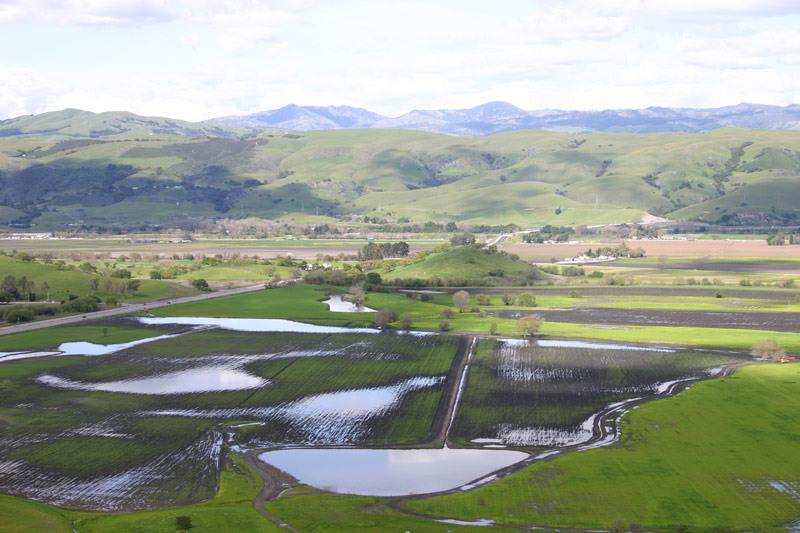
By Pat Ferraro. This article was originally published on the Sierra Club – Loma Prieta Chapter’s website. You can read the original post here.
“Coyote Valley acts essentially like a 7500-acre percolation pond and is the de facto forebay for the Santa Clara Groundwater Basin, which serves some 2 million residents and businesses in Santa Clara County.
For millennia, the Coyote Valley received the alluvial deposits from the upstream 200 square miles of the Coyote Watershed. These alluvial deposits consisted primarily of larger sands and gravels of high porosity and transmissibility. Because of this high porosity, horizontal movement down gradient north toward San Jose through the Coyote Valley has been measured at 10 feet per day. The basin is connected with and greatly influences the stream flow of the main stem of the Coyote Creek and vice versa.
We learned much about our groundwater basins’ physical properties through the unfortunate plume-chasing activities of the 1980’s and beyond when 10,000 monitoring wells were installed in the county to determine the extent and direction of hundreds of illegal discharges from leaking underground storage tanks.
Despite our county’s leadership in preventing future leaks from buried tanks, land use decisions by both the City of San Jose and Santa Clara County resulted in continued threats to the water quality of the Coyote Valley. The County permitted the use of lands adjacent to Andersen Lake to be used for a rocket testing site, releasing thousands of pounds of perchlorate and other chemicals, many of which are suspected carcinogens, into the watershed. This site continues to be under remediation.
The County staff got approval from the now-defunct Intergovernmental Council to approve the Kirby Canyon Landfill. Once opened, the unlined dump soon began leaking organic solvents, which had mostly been banned by international treaty to protect the planet’s ozone layer.
The relocation and expansion of the 101 freeway from the four-lane Monterey Highway into the eight-lane raceway along the foothills created a greater threat. Normal polluted road runoff multiplied into catastrophic spills from tanker trucks or other collisions, and vehicle fuel and lubricant leaks.
At the very least, signs should be placed along the freeway indicating to motorists that they are entering the Coyote Watershed. Emergency provisions like absorbent should be stockpiled for any catastrophic releases and all storm drains from the freeway discharging to the Coyote Valley should employ carbon filters to remove things like coolants, lubricants, and fuel.
 Managing polluted stormwater runoff in an area like Coyote Valley cannot be mitigated by installing simple grassy swales to intercept the water. Because the Coyote Valley is of such high porosity, these devices would allow all the dissolved material easy entry into the basin and pollute the
Managing polluted stormwater runoff in an area like Coyote Valley cannot be mitigated by installing simple grassy swales to intercept the water. Because the Coyote Valley is of such high porosity, these devices would allow all the dissolved material easy entry into the basin and pollute the
We learned a hard lesson during the 1980’s when companies like IBM and Fairchild Semiconductor leaked organic solvents into the groundwater basin, just north of the Coyote Valley. IBM spent around $100 million dollars pumping and treating a cocktail of multiple organic solvents leaked from their buried storage tanks. So much water flowed through the Fairchild site that an underground barrier had to be built around the site to stop the continued contamination of the underground river that flows out of the Coyote into the main Santa Clara Groundwater Basin.
If pollutant loadings to the Coyote Valley Groundwater Basin, and subsequently to the Santa Clara Groundwater Basin, are allowed to increase because of unmitigated urban stormwater runoff, eventually the water quality of both basins may reach concentrations of certain pollutants that would require expensive wellhead treatment before use as drinking water for the two million residents and workers of Silicon Valley. This cost would be hundreds of millions of dollars, and the costs would most likely be borne by the taxpayers and water ratepayers, while the developers would likely skate free of any liability.
It is, therefore, incumbent on us today to remain ever vigilant in protecting our precious groundwater, especially in the forebay region of the Coyote Valley.”
Pat Ferraro lectures at San Jose State University on Water Policy, is a former board member of the Santa Clara Valley Water District and was Executive Director of the Silicon Valley Pollution Prevention Center. He has closely followed proposed development of Coyote Valley.
About Protect Coyote Valley
The Protect Coyote Valley campaign is led by Committee for Green Foothills and supported by Greenbelt Alliance, Keep Coyote Creek Beautiful, Santa Clara Valley Audubon Society, Sierra Club Loma Prieta Chapter, and SAGE — Sustainable Agriculture Education. It aims to preserve Coyote Valley, San Jose as open space that offers flood-buffering wetlands, an essential wildlife habitat and migratory area, and active farmlands.
